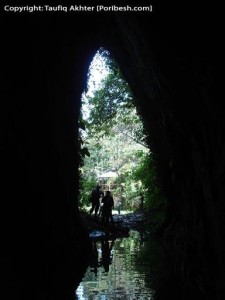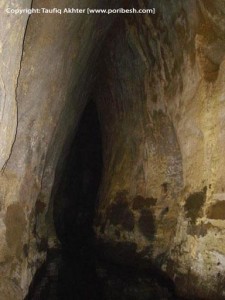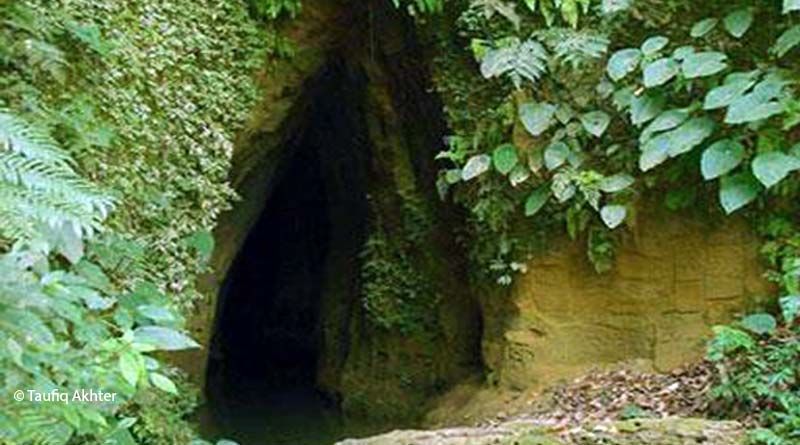Kudum Cave (Bat cave)
Bangladesh does not  have many bat caves that are widely known to the members of the public. Several species of bats have been known to be occupying permanent roosts in many tall trees, abandoned houses, monuments and dilapidated buildings and ruins of old forts in the country. Kudum Cave is the one that is known as a bats’ sanctuary to many people of the district of Cox’s Bazar that borders part of Arakan peninsula of Myanmar. In Chakma language ‘Kudum’ means long cave. It is possibly the most important and only publicly known bat cave in the country.
have many bat caves that are widely known to the members of the public. Several species of bats have been known to be occupying permanent roosts in many tall trees, abandoned houses, monuments and dilapidated buildings and ruins of old forts in the country. Kudum Cave is the one that is known as a bats’ sanctuary to many people of the district of Cox’s Bazar that borders part of Arakan peninsula of Myanmar. In Chakma language ‘Kudum’ means long cave. It is possibly the most important and only publicly known bat cave in the country.
A highway links Cox’s Bazar with Teknaf. At about the 52nd km on this road and from the village Whykeong, a track connects the highway with a coastal village called Shamlapur, which is a fishing village with a big daily market. The track is in an east-west direction and cuts across hilly terrain that no longer contains any natural evergreen forest but has occasional plantations of commercially viable species of timber. The highway and the coast of Bay of Bengal run parallel to the Teknaf Peninsula toward the south.
Description of Kudum Cave
Kudum Cave is within the Whykeong Range, under Cox’s Bazar Forest Division and Chittagong Forest Circle. Administratively it is under the Whykeong Union Porishad, Teknaf Police Station and Cox’s Bazar district.
 The uniqueness of the Kudum Cave is that it is not formed of any rocky material but clayey-sandy soil that are characteristic of Cox’s Bazar hills. The cave is in an east-west direction. It measures 38m in length; width at the entrance is about 2m and ranges from less than 1m at the extreme end to 2.5m at the widest place. The height varies from 10 to 14m. From inside, the cave seems to have three continuous chambers with slight variations in roof heights. The roof is convex, whereas the wall is rather concave. Just a metre below the roof in the middle and last chambers there is a kind of flat platform less than a metre in width, running along the length of the cave wall. The Cave slopes gently down at its end part and merges with its floor in a concave manner. This narrow end always receives seepage water. The rest of the cave does not show continuous flow of water. But there are signs on the wall that water has drained through many places of the wall during monsoon. However, along the bottom edges of the cave there are signs of feeble flow of water. Throughout the bottom of the cave, water level ranges from 30cm to 60cm and there is water all year round. In monsoon, water level rises slightlyto a metre or so. The entrance to the cave is not more than 4-5m in height, so light does not reach the roof of the cave after the first few metres. It is pitch dark in the last chamber or last three metres of the cave-end.
The uniqueness of the Kudum Cave is that it is not formed of any rocky material but clayey-sandy soil that are characteristic of Cox’s Bazar hills. The cave is in an east-west direction. It measures 38m in length; width at the entrance is about 2m and ranges from less than 1m at the extreme end to 2.5m at the widest place. The height varies from 10 to 14m. From inside, the cave seems to have three continuous chambers with slight variations in roof heights. The roof is convex, whereas the wall is rather concave. Just a metre below the roof in the middle and last chambers there is a kind of flat platform less than a metre in width, running along the length of the cave wall. The Cave slopes gently down at its end part and merges with its floor in a concave manner. This narrow end always receives seepage water. The rest of the cave does not show continuous flow of water. But there are signs on the wall that water has drained through many places of the wall during monsoon. However, along the bottom edges of the cave there are signs of feeble flow of water. Throughout the bottom of the cave, water level ranges from 30cm to 60cm and there is water all year round. In monsoon, water level rises slightlyto a metre or so. The entrance to the cave is not more than 4-5m in height, so light does not reach the roof of the cave after the first few metres. It is pitch dark in the last chamber or last three metres of the cave-end.
The nearest human settlement is within two kilometres of the cave, along the Whykeong-Shamlapur trail. Some 50 families of Chakma tribesmen reside in this village, called Hori Khola. According to some old men from this village and others from Whykeong, the cave has been there at least for the past two centuries. However, it might have existed there for a millennium or so.
Chakma Folktale about Kudum Cave
Once upon a time a beautiful fairy lived inside the Kudum Cave. Legend has beyond that cave been golden corn and paddy fields and a vast grass field. The fairy weaved cloths with gold threads. A Shepherd used to come to the forest everyday. The fairy fell in love with him. She brought the Shepherd inside and treated him with delicious foods everyday. She offered grass for his cows. The fairy made the Shepherd promise not to tell about her and the cave to anybody. A wizard from the Arakan came to know that by owning the fairy’s eyes he can become immortal. So he came and lured the Shepherd. The wizard gave spelled water to throw at the fairy saying that then the Shepherd will get all the wealth of the fairy. The wizard started casting spell. The fairy was agonized and turned into a tiger to escape. At the entrance the Shepherd throw water at her. The black magic water turned the fairy into a statue. The wizard also killed the Shepherd and destroyed the wonderland inside the cave. It is said even now if someone goes alone there then sometimes can see the fairy’s statue.
Several types of Bat use this cave as their habitat. The sound of the bats can be heard from a distance of 500m during quiet days and we can smell them from 200 to 500m, depending on the wind’s direction. Sometimes the Fruit Bats were seen flying out of the cave when we entered it and used flashlights to spot them. The Insect Bats did not go out but kept changing places inside the cave.As per the indigenous Chakma villagers the bats have occupied the cave for centuries. This cave is playing an important role in the existence of local biodiversity.
Source: from the news article of Dr. Reza Khan
Compilation & Photo: Taufiq Akhter

